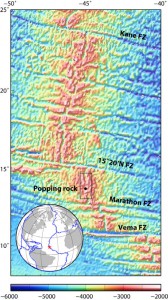Check back soon to learn more about where we’ll be working throughout the Popping Rocks 2018 expedition. In the meantime, learn more about the global mid-ocean ridge and look back at the 2016 blog posts. We will leave from Bermuda and it will take about six days to reach the work area, near 14 degrees North on the Mid-Atlantic Ridge.
Image: A bathymetric map of the Mid-Atlantic Ridge between 10° and 24°N with the Popping Rocks study outlined in black near 14°N (click to enlarge).




